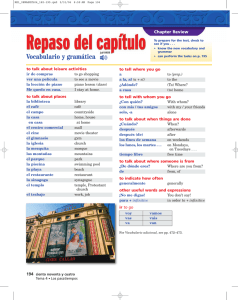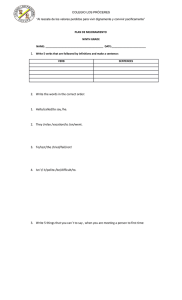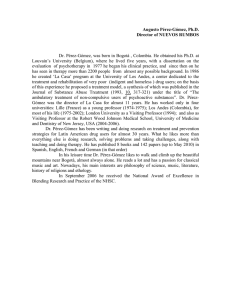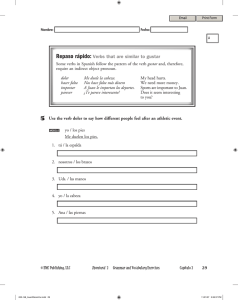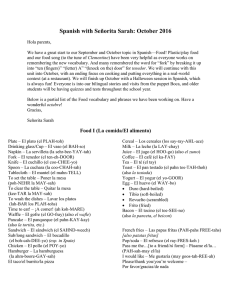When to use the article en español
Anuncio
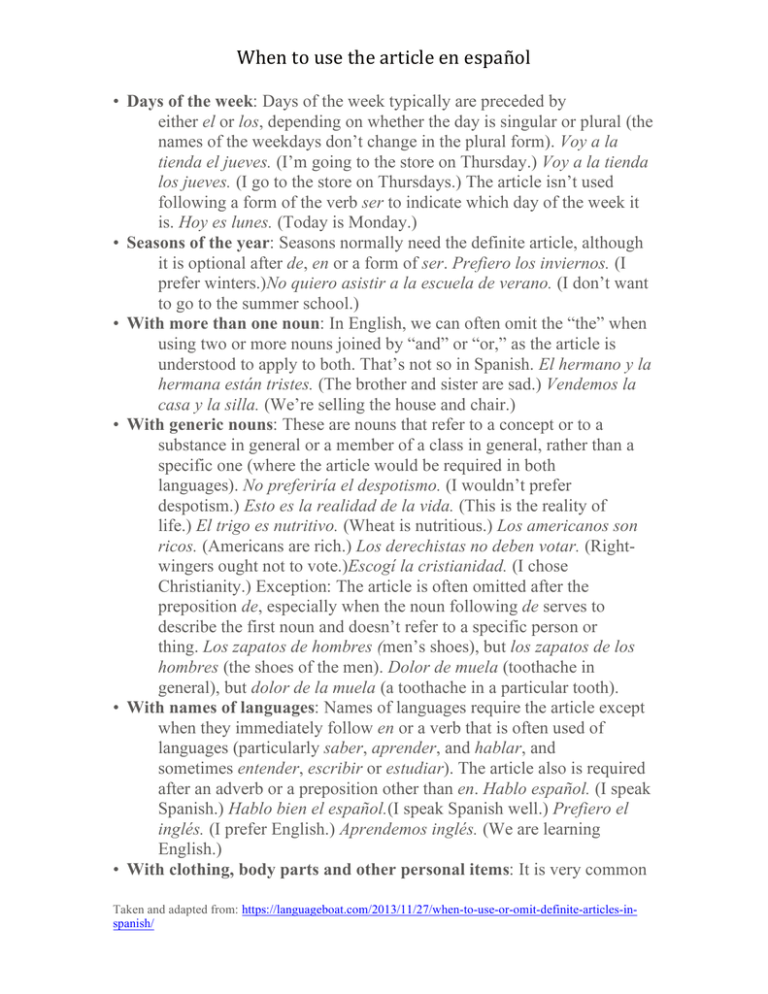
When to use the article en español • Days of the week: Days of the week typically are preceded by either el or los, depending on whether the day is singular or plural (the names of the weekdays don’t change in the plural form). Voy a la tienda el jueves. (I’m going to the store on Thursday.) Voy a la tienda los jueves. (I go to the store on Thursdays.) The article isn’t used following a form of the verb ser to indicate which day of the week it is. Hoy es lunes. (Today is Monday.) • Seasons of the year: Seasons normally need the definite article, although it is optional after de, en or a form of ser. Prefiero los inviernos. (I prefer winters.)No quiero asistir a la escuela de verano. (I don’t want to go to the summer school.) • With more than one noun: In English, we can often omit the “the” when using two or more nouns joined by “and” or “or,” as the article is understood to apply to both. That’s not so in Spanish. El hermano y la hermana están tristes. (The brother and sister are sad.) Vendemos la casa y la silla. (We’re selling the house and chair.) • With generic nouns: These are nouns that refer to a concept or to a substance in general or a member of a class in general, rather than a specific one (where the article would be required in both languages). No preferiría el despotismo. (I wouldn’t prefer despotism.) Esto es la realidad de la vida. (This is the reality of life.) El trigo es nutritivo. (Wheat is nutritious.) Los americanos son ricos. (Americans are rich.) Los derechistas no deben votar. (Rightwingers ought not to vote.)Escogí la cristianidad. (I chose Christianity.) Exception: The article is often omitted after the preposition de, especially when the noun following de serves to describe the first noun and doesn’t refer to a specific person or thing. Los zapatos de hombres (men’s shoes), but los zapatos de los hombres (the shoes of the men). Dolor de muela (toothache in general), but dolor de la muela (a toothache in a particular tooth). • With names of languages: Names of languages require the article except when they immediately follow en or a verb that is often used of languages (particularly saber, aprender, and hablar, and sometimes entender, escribir or estudiar). The article also is required after an adverb or a preposition other than en. Hablo español. (I speak Spanish.) Hablo bien el español.(I speak Spanish well.) Prefiero el inglés. (I prefer English.) Aprendemos inglés. (We are learning English.) • With clothing, body parts and other personal items: It is very common Taken and adapted from: https://languageboat.com/2013/11/27/when-to-use-or-omit-definite-articles-inspanish/ When to use the article en español to use the definite article in Spanish in cases where a possessive adjective (such as “your”) would be used in English. Examples: ¡Abre los ojos! (Open your eyes!)Perdió los zapatos. (He lost his shoes.) • With infinitives used as subjects: El entender es difícil. (Understanding is difficult.) El fumar está prohibido. (Smoking is prohibited.) • Before the names of some countries: The names of some countries, and a few cities, are preceded by the definite article. In some cases it’s mandatory or nearly so (el Reino Unido, la India), while in other cases it’s optional but common (el Canadá, la China). Even if a country isn’t on the list, the article is used if the country is modified by an adjective. Voy a México. (I’m going to Mexico.) But, voy al México bello. (I’m going to beautiful Mexico.) The article is also commonly used before the names of mountains: el Everest, el Fuji. • Before names of streets: Streets, avenues, plazas and similar places are usually preceded by the article. La Casa Blanca está en la avenida Pennsylvania. (The White House is on Pennsylvania Avenue.) • With personal titles: The article is used before most personal titles when talking about people, but not when talking to them. El señor Smith está en casa. (Mr. Smith is at home.) But,hola, señor Smith (hello, Mr. Smith). La doctora Jones asistió a la escuela. (Dr. Jones attended the school.) But, doctora Jones, ¿como está? (Dr. Jones, how are you?) La is also often used when speaking about a famous woman using her last name only. La Spacek durmió aquí.(Spacek slept here.) In certain set phrases: Many of these involve places. En el espacio (in space), en la televisión(on television). When it is omitted? • Before ordinal numbers for names of rulers and similar people. Luis octavo (Luis the Eighth), Carlos quinto (Carlos the Fifth). • Some proverbs (or statements made in a proverbial fashion) omit the article. Camarón que se duerme, se lo lleva la corriente. (The shrimp that falls asleep gets carried away by the current.) Perro que ladra no muerde. (The dog that barks doesn’t bite.) In certain set phrases that don’t follow any particular pattern. Examples: A largo plazo (in the long run), en alta mar (on the high seas) Taken and adapted from: https://languageboat.com/2013/11/27/when-to-use-or-omit-definite-articles-inspanish/
